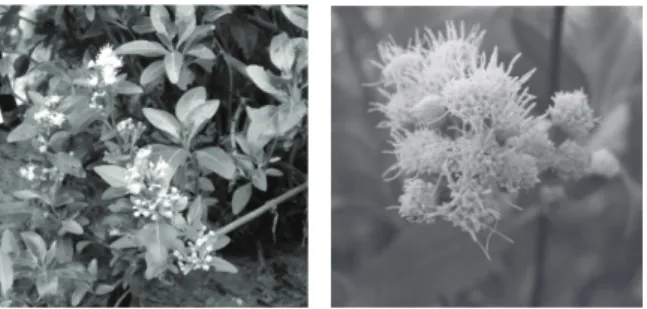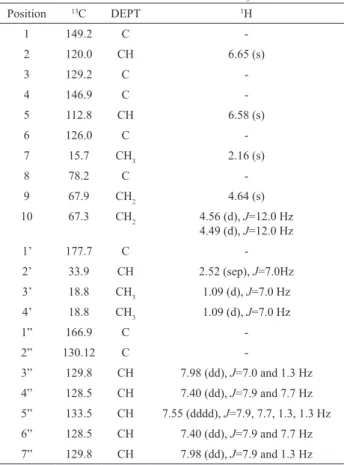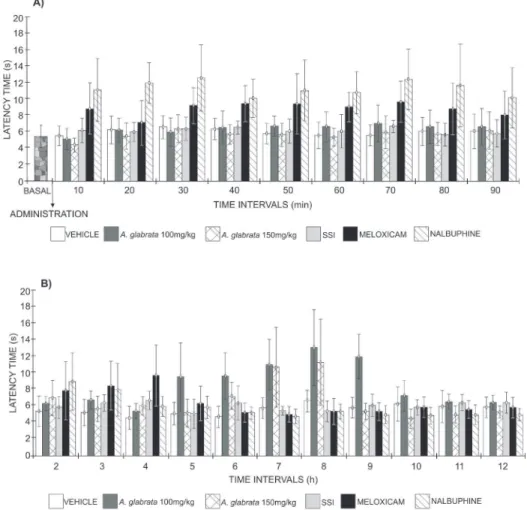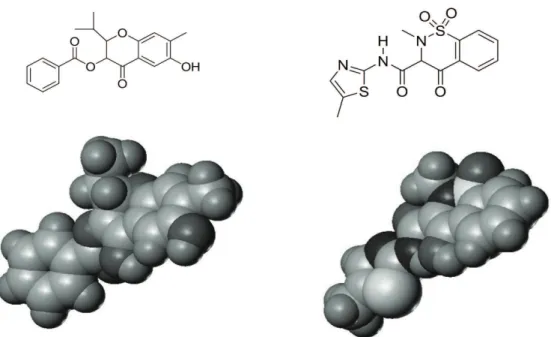Article
ISSN 0102-695X
http://dx.doi.org/10.1590/S0102-695X2011005000158 Received 20 Dec 2010 Accepted 20 Jun 2011 Available online 2 Sep 2011
glabrata
in the hot plate test
Guadalupe García P,
1Edgar García S,
3Isabel Martínez G,
1Thomas R. F. Scior,
2José L Salvador,
3Mauro M Martínez P,
3Rosa E. del Río
*,31Laboratorio de Neuroquímica, Facultad de Ciencias Químicas, Benemérita
Universidad Autónoma de Puebla, Puebla, Mexico,
2Laboratorio de Farmacomodelaje, Facultad de Ciencias Químicas, Benemérita
Universidad Autónoma de Puebla, Puebla, Mexico,
3Instituto de Investigaciones Químico-Biológicas, Universidad Michoacana de San
Nicolás de Hidalgo, Morelia, Mexico.
Abstract: Ageratina glabrata (Kunth) R.M. King & H. Rob., Asteraceae (syn.
Eupatorium glabratum Kunth) is widely distributed throughout Mexico and popularly known as “chamizo blanco” and “hierba del golpe” for its traditional use as external analgesic remedy. Though glabrata species has been chemically studied, there are no experimentally asserted reports about possible analgesic effects which can be inferred from its genus Ageratina. To fill the gap, we evaluated A. glabrata
extracts in an animal model of nociception exploiting thermal stimuli. NMR and mass analyses identified a new thymol derivative, 10-benzoiloxy-6,8,9-trihydroxy-thymol isobutyrate (1), which was computationally converted into a ring-closed structure to explain interaction with the COX-2 enzyme in a ligand-receptor docking study. The resulting docked pose is in line with reported crystal complexes of COX-2 with chromene ligands. Based on the present results of dichloromethane extracts from its dried leaves, it is safe to utter that the plant possesses analgesic effects in animal tests which are mediated through inhibition of COX-2 enzyme. Keywords:
Ageratina glabrata
10-benzoiloxy-6,8,9-trihydroxy-thymol isobutyrate
analgesia rats extract pain nociception
Introduction
Pain is a subjective experience that is the result of the perception of an injurious stimulus and includes an emotional component that requires that the individual is conscious so that this happens. In 1986, the International
Association for the Study of Pain (IASP) dei ned pain as
an unpleasant sensory and emotional experience associated with actual or potential tissue damage, or described in terms of such damage (Merskey & Bogduk, 1994). But, the pain has a physiological component, which is called nociception. That is the process by which intense thermal, mechanical or chemical stimuli are detected by a subpopulation of
peripheral nerve i bers, called nociceptors (Basbaum &
Jessell, 2000). The information is processed via specialized central nervous system pathways (Danneman, 1997).
The animal models for the study of the pain measure the latency time and/or the threshold of the escape responses evaluating the effect of several drugs in the nociceptive responses that are those associated with the injurious stimulation perceived by the nociceptors (Danneman, 1997). The models of acute pain by application of intense stimuli of short duration induce
changes in motor rel exes or behavior such as retirement rel exes, vasomotor changes and vocalization, besides not
requiring the accomplishment of a previous injury in the animal (González-Darder, 2000). Therefore, nociception is susceptible to a pharmacological blockade for the treatment of the pain and the common analgesic drugs are opioids and non-opioids drugs. But these drugs have disadvantages in the dosage, gastrointestinal problems, dependence and others. Different species of plants are used in folk medicine as an alternative for treatment of diseases and the traditional uses of plants as herbal remedies have played a vital role in the discovery of new molecules as therapeutic agents.
Robinson (1970). It is found in the tropical and temperate regions of Europe and America, especially Mexico.
The plant under investigation, Ageratina glabrata (Kunth) R.M. King & H. Rob. (syn. Eupatorium glabratum Kunth) (King & Robinson, 1970), is popularly known as “chamizo blanco” or “hierba del golpe” which means “white greasewood” and “contusion herb“. The rural population recognizes its pain - relief effects in external remedies. Reports from the literature
describe lavones, thymol derivatives and other phenolic
terpenoids (Romo de Vivar et al., 1971; Bohlmann et al., 1977; Guerrero et al., 1978). Though A. glabrata has
been chemically studied, there are no scientiic reports
about its analgesic effects. Therefore, we studied this Mexican plant extract in a hot plate model of nociception exploiting distinct thermal stimuli.
Materials and Methods
General
NMR measurements, including DEPT
experiments, were performed at 400 MHz for 1H and 100 MHz for 13C on a Varian Mercury Plus 400 spectrometer, using CDCl3 as the solvent and TMS as internal reference. Mass spectra were recorded at 20 eV on a Hewlett-Packard 5989B Series II Plus spectrometer adapted to a HP 5890 gas chromatography. Column chromatography was carried out on Merck silica gel grade 60 (70-230 mesh).
Plant material
Specimens of Ageratina glabrata (Kunth) R.M. King & H. Rob., Asteraceae, were collected on January 4, 2006 near km 191 of México-Morelia state road No.15, in the municipality of San José de la Cumbre, State of Michoacán, México (N 19°40’859’’, W 100°50’423’’ and 2,234 meters above sea level). A voucher specimen (No. 188319) is deposited at the Herbarium of the Instituto de Ecología, A.C., Centro Regional del Bajío, Pátzcuaro, Michoacán, Mexico, where Prof. Jerzy Rzedowski kindly
identiied the plant material (Figure 1).
Figure 1. Photos of A. glabrata by Dr. Rosa E. del Río. The
rhomboid-shaped leaves and lower grouping are clearly visible.
Preparation of plant extract
Air-dried leaves of A. glabrata (200 g) were extracted with CH2Cl2 (1.5 L) at room temperature for three days, three consecutive times. Filtration and evaporation of the extract afforded green viscous oil (19 g).
Isolation of the thymol derivative (1) from dichloromethane extract
The dichloromethane extract (0.5 g) was chromatographed on silica gel column using n-hexane and
ethyl acetate mixture of increasing polarity, and inally pure
ethyl acetate. Elution with hexane:EtOAc (9:1) afforded a mixture of thymol derivatives. The sub-fraction 30-32 (100 mg) was subjected to rechromatography on silica gel (5 g). Elution with n-hexane-AcOEt (8:2) afforded pure 10-benzoiloxy-6,8,9-trihydroxy-thymol isobutyrate (1)
(20 mg). Identiication was supported by spectroscopic
analyses.
Animals
Female Sprague Dawley rats (180-200 g) were used for the study. The animals were housed in rooms maintained at 24±2 °C, twelve-hours-light-darkness cycle and maintained with ad libitum access to Harlan Tekland Global Diets® and bottled water. The animals were handled 3 min a day for four weeks until the experiment day. All animal experiments complied with recommendations of the Regulation of the Committee for the Care and Use of Laboratory Animals of the Benemérita Universidad Autónoma de Puebla in 2007, which provides
for compliance with Mexican Oficial Norm (NOM-062-ZOO-1999) appendix A, about the “Speciications for the
production, care and use of laboratory animals” (Secretaría de Agricultura, Ganadería, Desarrollo Rural, Pesca y Alimentación; 2001).
Hot plate test
The extract was dissolved in sesame oil and administered to animals intraperitoneally at doses of 100 mg/Kg (n=9) and 150 mg/kg (n=10). The control group (n=8) was intraperitoneally exposed to a vehicle (0.7 mL) of pure sesame oil. In addition, independent groups of rats received, meloxicam intraperitoneally (n=8) at a dose of 4 mg/kg and nalbuphine (n=8) at a dose of 5 mg/kg. The control group (n=7) received isotonic saline solution (SSI, 0.4 mL). In the hot plate test, all animals were placed on a hot plate maintained at a temperature
of 40 °C. The antinociceptive effect was quantiied by
control test, all animals had just been exposed to the hot plate in order to observe the so-called pre-injection-latency times, of which three measurements were taken. Each animal was repeatedly placed on the hot plate in time intervals of 10, 20, 30, 40, 50, 60, 70, 80 and 90 min after injection. The observation series of each animal was continued in order to collect data for every other hour
until reaching the deined limit of 12 h evaluation time.
Docking simulations
The chromene derivative computationally
modiied and the control structure meloxicam (Engelhardt
et al., 1995) were docked manually into the COX-2 catalytic site. This study was performed with the Sybyl®X software suite (Tripos International, 2010).
Vaginal smears
The vaginal smears were used to detect the phase of the estrous cycle during the hot plate test. We used this method as a control to determine whether the
estrous cycle has inluence on the latency times in the hot
plate test.
Autopsy
The rats were observed for ten days after the nociception test in order to determine possible changes in the intake of food and water. On day eleven, animals
were randomized and sacriiced using an overdose of
sodium pentobarbital (55 mg/kg intraperitoneally). At autopsy the organs (heart, liver, kidneys, lungs, spleen, intestine and adjacent tissue to the administration area of A. glabrata) were given a macroscopic examination about their size, shape, color and texture.
Statistical analysis
Data were analyzed by one way ANOVA and were expressed as the means and respective standard deviation. This analysis allows checking as to whether there are any
statistically signiicant differences (p<0.05) between the mean latency times of the groups. To determine which groups are different, the data were analyzed by Tukey test. In addition, Dunnett test was used to compare the experimental groups versus respective control group using Statistica program.
Results and Discussion
The dichloromethane extract of A. glabrata leaves was fractionated by column chromatography affording a pure compound 10-benzoiloxy-6,8,9-trihydroxy-thymol isobutyrate (1). The mass spectrum
indicated a molecular ion at m/z 388 in agreement with the molecular formula C21H24O7, m/z 370 (12%) [M-H2O]+, 178 (46%), 165 (43%), 150 (15%), 137 (5 %), 122 (23%), 105 (100%), 91 (5%), 71 (40%). The 1H NMR spectrum (Figure 2) indicates the presence of
a benzoate group at 7.98, 7.55 and 7.40 ppm; singlets at 6.65 and 6.58 ppm for 2 and 5 aromatic hydrogens, respectively. The signals for the isopropyl group at 2.52 and 1.09 ppm. A singlet at 4.64 ppm for two hydrogens of methylene group in the 10-position of the molecule and the hydrogens of methylene group in C-9 were observed as a doublet each at 4.56 and 4.49 ppm. The 13C NMR spectrum (Table 1) was in agreement with the proposed structure. Eleven thymol derivatives have been obtained by Bohlmann et al 1977 from A. glabrata, but all of them differ from the new thymol derivative 1.
Table 1. NMR data for compound 1 in CDCl3.
Position 13C DEPT 1H
1 149.2 C
-2 120.0 CH 6.65 (s)
3 129.2 C
-4 146.9 C
-5 112.8 CH 6.58 (s)
6 126.0 C
-7 15.7 CH3 2.16 (s)
8 78.2 C
-9 67.9 CH2 4.64 (s)
10 67.3 CH2 4.56 (d), J=12.0 Hz
4.49 (d), J=12.0 Hz
1’ 177.7 C
-2’ 33.9 CH 2.52 (sep), J=7.0Hz 3’ 18.8 CH3 1.09 (d), J=7.0 Hz 4’ 18.8 CH3 1.09 (d), J=7.0 Hz
1” 166.9 C
-2” 130.12 C
-3” 129.8 CH 7.98 (dd), J=7.0 and 1.3 Hz 4” 128.5 CH 7.40 (dd), J=7.9 and 7.7 Hz 5” 133.5 CH 7.55 (dddd), J=7.9, 7.7, 1.3, 1.3 Hz 6” 128.5 CH 7.40 (dd), J=7.9 and 7.7 Hz 7” 129.8 CH 7.98 (dd), J=7.9 and 1.3 Hz
The results obtained from this study relect an
analgesic effect for A. glabrata (100 mg/kg), meloxicam (4 mg/kg) and nalbuphine (5 mg/kg). The analysis of
the data has revealed that a signiicant difference exists
between control (vehicle and SSI) and experimental (verum) groups at doses of 100 mg/kg (p<0.05). The
injected extract produced a signiicant increase in reaction
during the eighth hour after injection at a dose level of 100 mg/kg. Intriguingly, dose augmentation did not enhance protective effects (a higher level of 150 mg/kg).
Figure 2. 400 MHz 1H-NMR spectrum of 10-benzoiloxy-6,8,9-trihydroxy-thymol isobutyrate (1).
Figure 3. The latency times of the substances and analgesics during the hot plate test for A. the irst 90 minutes and B. continuous hourly sampling until reaching 12 h evaluation time. Each point represents the mean values of the latency time group and respective
standard deviation. One way ANOVA tests show statistically signiicant differences (p<0.05) between all groups. On the other
hand, the Tukey test inds no statistically signiicant difference between the verum group of A. glabrata (100 mg/kg), and both
positive controls (meloxicam and nalbuphine) but in contrast to the A. glabrata 150 mg/kg group which does show a statistically
signiicant difference with both controls (logically, vehicle and SSI do show). The basal irst sample point in A. represents the
Based on theoretical grounds and known literature the thymol derivative 1 is converted into a bicyclical system via a ring closure reaction of condensation type (Paredes & Clemente, 2005; Tenorio et al., 2006; Chemler et al., 2009). This occurs on the original thymol derivative 1 which was identified through NMR by our group. We postulate that it is chemically converted into a compound similar to positive control meloxicam which itself is a known COX-2 inhibitor (Engelhardt et al., 1995, Gris et al., 2009). To determine whether this plausible compound (Figure 4) could also block the enzyme COX-2 a docking study was conducted by Sybyl® X software suite (Tripos International, 2010) to position the chromene derivative into the binding pocket of meloxicam, exploring the interacting amino acids and complementary shape information (Wang et al., 2007). The target structure is a human COX-2 enzyme, also called prostaglandin synthase-2 (Padhye et al., 2009). The target receptor was downloaded from the Protein Data Bank site (Berman et al., 2000). Its entry code is 3LN0 (Wang et al., 2010). As a result, both the chromene derivative and the meloxicam ligands were successfully docked into the same orientation and position as seen on the experimental chromene-COX-2 complex. The crystal chromene ligand, meloxicam and our ring-closed chromene derivative have an analogous bicyclical system in common (Figure 4). Hence, the orientation and binding mode of our computed models are in good agreement with the related crystallographic structure (Figure 5).
The analgesia of the non steroidal
anti-inlammatory drugs (NSAID) like meloxicam which
was used as positive control, is longer than that seen under opioid analgesic drugs application (positive control nalbuphine). NSAID inhibit the synthesis of prostaglandins by cyclooxygenase (COX) enzymes. Certain prostaglandins mediate pain processes (Vanegas & Schaible, 2001). Therefore, the observed analgesic effect of the leaf extract from A. glabrata suggests that the underlying molecular mechanism is mediated via COX because of its duration and pain-suppressing character.
The COX enzyme is divided into two isoforms. COX-1 is expressed constitutively throughout the body while the expression of COX-2 is inducible. However in spinal cord and brain, particularly in hippocampus, cortex and amygdala, both isoforms are expressed constitutively.
This inding supports the idea that NSAID also act in the
spinal cord by inhibiting prostaglandin synthesis and their effect is demonstrated in models of supraspinal analgesia as the hot plate test (Vanegas & Schaible, 2001).
Contemporary research and development for potential new analgesics focus on selective COX-2 inhibition, in order to lower the incidence of gastrointestinal and renal side effects ascribed to COX-1 inhibition (Gajraj, 2003). Hence a docking study was conducted to dock meloxicam and the proposed chromene derivative into the active site of COX-2 target. The chromene structure was hypothetically designed based on the extracted thymol derivative 1 which was identiied
through NMR analyses.
On the other hand, there is controversy concerning the use of female rats in models of pain with regard to missing data about the hormonal action mechanism (Gordon & Soliman, 1996; Vinogradova et al., 2003; Kuba et al. 2006). The estrous cycle lasts on average four days. It consists of four phases which are proestrus, estrus, metaestrus and diestrus. In each stage variable hormone concentrations are found such as prolactin, LH, FSH, estradiol, or progesterone. Each phase of the estrous cycle is determined by a ratio of three types of cells obtained by vaginal smears (Marcondes,
2002): epithelial cells, corniied cells and leukocytes
(Figure 6A-D).
The inluence of the phases of estrous cycle on
the latency times in hot plate test, vaginal smears was performed in rats of the negative controls (vehicle and
SSI). During the hot plate test vaginal smears were performed, one at ninety minutes and again at seven
hours. The statistical analysis shows no signiicant
difference between the latency times and the phases of the estrous cycle (proestrus, estrus, and diestrus metaestrus). There is no correlation or trend between values of latency times and the phases of the estrous cycle of female rats. Hence, the latency time values of four groups with either A. glabrata 100 mg/kg, 150 mg/kg, meloxicam or
nalbuphine treatments are not inluenced by hormonal
stages but only due to full drug effects either through the extract itself or the positive controls (Figure 6E, F). Our study design allows similar interpretation about “no
hormonal inluence” as earlier reported by Ratnasooriya
et al. (2002) and Kiasalari et al. (2010).
At autopsy there were no injuries during the
macroscopic examination in the heart, liver, kidneys, lungs, spleen, intestine and adjacent tissue to the administration area of leaves extract of A. glabrata or vehicle. This
relects that the extract formulation is well-tolerated and
administration is well performed. In addition, during the
hot plate test, all animals did not show speciic signs of
pain such as piloerection, aggression, hunched posture, abdominal writhing, squeals on handling or pressure on administration area. They are exhaustively described by the Committee on Recognition and Alleviation of Distress in Laboratory Animals and Institute for Laboratory Animal Research (2008). Moreover, no animal died during or after treatment.
Acknowledgment
The authors thank Dr. Carlos Escamilla Weinmann, director of the Bioterium Claude Bernard of the Benemérita Universidad Autónoma de Puebla and his staff for the animals provided. Thanks are given to Dr. Jerzy Rzedowski for identifying of A. glabrata. Also thanks for Prof. Dr. U. Zaehringer, Forschungszentrum
Borstel, Germany, for the Sybyl licencing at our site.
Partial inancial support from CIC-UMSNH and
CONACYT (118287), Mexico, is acknowledged Edgar García S. thank CONACYT for fellowship No. 205612.
References
Basbaum AI, Jessell TM 2000. Perception of pain. In: Kandel ER, Schwartz JH y Jessell TM (eds). Principles of Neural Science. 4. ed. New York: The McGraw-Hill, p 474-492. Berman HM, Westbrook J, Feng Z, Gilliland G, Bhat TN,
Weissig H, Shindyalov IN, Bourne PE 2000. The protein data bank. Nucleic Acids Res 28: 235-242.
Bohlmann F, Jakupovic J, Lonitz M 1977. Über Inhaltsstoffe der Eupatorium-Gruppe. Chem Ber 110: 301-314. Chakravarty AK, Mazumder T, Chatterjee SN 2010.
Anti-inlammatory potential of ethanolic leaf extract of
Eupatorium adenophorum Spreng. Through Alteration
in Production of TNF-α, ROS and expression of certain
genes. Evid-based Compl Alt, Article ID 471074, doi:10.1093/ecam/neq033.
Chemler JA, Leonard E, Koffas MAG 2009. Flavonoid Figure 6. The phases of the estrous cycle: A. proestrus (n=4); B. estrus (n=4); C. metaestrus (n=4) and D. diestrus (n=3). Samples
were prepared with hematoxylin and eosin stain under 40-fold microscopic magniication. The histogram bars show the mean and
respective standard deviation values of the latency times for the control groups (vehicle and SSI) according to the phase of the estrus
cycle at 90 minutes (E) and 7 h (F). Statistical analysis (one way ANOVA) does not show statistically signiicant difference between
biotransformation in microorganisms. In: Gould K,
Davies K, Wineiled C (eds) Anthocyanins: biosynthesis,
functions and applications. New York: Springer, p.191-256.
Committee on Recognition and Alleviation of Distress in Laboratory Animals, Institute for Laboratory Animal Research 2008. Recognition and alleviation of distress in laboratory animals. Washington, DC: The national Academies Press.
Danneman PJ 1997. Monitoring of Analgesia. In: Kohn DF, Wixson SK, White WJ, Benson GJ (eds). Anesthesia and Analgesia in Laboratory Animals. New York: Academic Press, p.83-103.
Engelhardt G, Homma D, Schlegel K, Utzmann R, Schnitzler
C 1995. Anti-inlammatory, analgesic, antipyretic and
related properties of meloxicam, a new non-steroidal
anti-inlammatory agent with favourable gastrointestinal
tolerance. Inlamm Res 44: 423-433.
Gajraj NM 2003. Cyclooxygenase-2 inhibitors. Anesth Analg 96: 1720-1738.
González-Darder JM 2000. Animal pain models and ethical issues regarding animal experimentation. Rev Soc Esp Dolor 7: 313-318.
Gordon FT, Soliman MRI 1996. The effects of estradiol and progesterone on pain sensitivity and brain opioid receptors in ovariectomized rats. Horm Behav 30: 244-250.
Gris JH, Dragonetti MA, Fernández BM, Moglioni AG 2009. Molecular modelling and docking studies
of antiinlammatory derivatives of 4-hydroxi,
1,2-benzothiazine 1,1-dioxide. Inf Tecnol 204: 51-61. Guerrero C, Silva M, Maldonado E, Martínez M 1978.
Eupaglabric acid a new compound isolated from
Eupatorium glabratum H.B.K. Rev Latinoamer Quím 9: 71-75.
Kiasalari Z, Khalili M, Ashrai M 2010. Anti-nociceptive effect
of alcoholic extract of henbane seed on the different phases of estrous cycle of female rats. J Gorgan Uni Med Sci 11: 1-7.
King RM, Robinson H 1970. Studies in the Eupatorieae (Compositae) new combinations in Ageratina.
Phytologia 19: 208-229.
Kuba T, Wu HBK, Nazarian A, Festa ED, Barr GA, Jenab S, Inturrisi CE, Quinones-Jenab V 2006. Estradiol and progesterone differentially regulate formalin-induced nociception in ovariectomized female rats. Horm Behav
49: 441-449.
Mandal SK, Boominathan R, Parimaladevi B, Dewanjee S, Mandal SC 2005. Analgesic activity of methanol extract of Eupatorium adenophorum Spreng. leaves. Indian J
Exp Biol 43: 662-663.
Marcondes FK, Bianchi FJ, Tanno AP 2002. Determination of the estrous cycle phases of rats: some helpful considerations. Braz J Biol 62: 609-614.
Merskey H, Bogduk N 1994. Part III: Pain terms, a current
list with deinitions and notes on usage. Seattle: IASP Press.
Padhye S, Banerjee S, Chavan D, Pandye S, Swamy KV, Ali S, Li J, Dou QP, Sarkar FH 2009. Fluorocurcumins as cyclooxygenase-2 inhibitor: molecular docking. Pharm Res 26: 2438-2445.
Paredes SF, Clemente FA 2005. Polifenoles de aplicación en farmacia: metabolismo y acción biológica. OFFARM
24: 85-94.
Ratnasooriya WD, Dharmasiri MG, Rajapakse RA, De Silva MS, Jayawardena SP, Fernando PU, De Silva WN, Nawela AJ, Warusawithana RP, Jayakody JR, Digana PM 2002. Tender leaf extract of Terminalia catappa antinociceptive activity in rats. 2002. Pharm Biol 40: 60-66.
Romo de Vivar A, Cuevas LA, Guerrero C 1971. Eupaglabrin a terpene from Eupatorium glabratum. Rev Latinoamer Quím 2: 32-34.
Secretaría de Agricultura, Ganadería, Desarrollo Rural, Pesca
y Alimentación 2001. Especiicaciones técnicas
para la producción, cuidado y uso de los animales de laboratorio. Diario Oicial de la Federación de México. United Mexican States.
Tenorio LFA, Del Valle ML, Pastelín HG 2006. Flavonoids and the cardiovascular system: can they be a therapeutic alternative? Arch Cardiol Mex 76: 33-45.
Tripos International 2010. 1699 South Hanley Rd., St. Louis, Missouri, 63144, USA.
Vanegas H, Schaible HG 2001. Prostaglandins and cycloxygenases in the spinal cord. Prog Neurobiol 64: 327-363.
Vinogradova EP, Zhukov DA, Batuev AS 2003. The effects of stages of the estrous cycle on pain thresholds in female white rats. Neurosci Behav Physiol 33: 269-272. Wang JL, Limburg D, Graneto MJ, Springer J, Hamper JRB,
Liao Subo, Pawlitz JL, Kurumbail RG, Maziasz T, Talley JJ, Kiefer JR, Carter J 2010. The novel benzopyran class of selective cyclooxygenase-2 inhibitors. Part 2: The second clinical candidate having a shorter and favorable human half-life. Bioorg Med Chem Lett 20: 7159-7163.
Wang M, Hampson DR, Kotra LP 2007. In silico molecular homology modeling of neurotransmitter receptors. In: Lajtha A, Baker G, Dunn S, Holt A, Wang M, Hampson D, Kotra L (eds). Handbook of neurochemistry and molecular neurobiology. 3. ed. New York: Springer, p. 294-304.
*Correspondence
Rosa E. del Río
Instituto de Investigaciones Químico-Biológicas, Universidad Michoacana de San Nicolás de Hidalgo.
Ed. B-1, C.U. Morelia, Mich.,58030, Mexico. ndelrio@umich.mx



